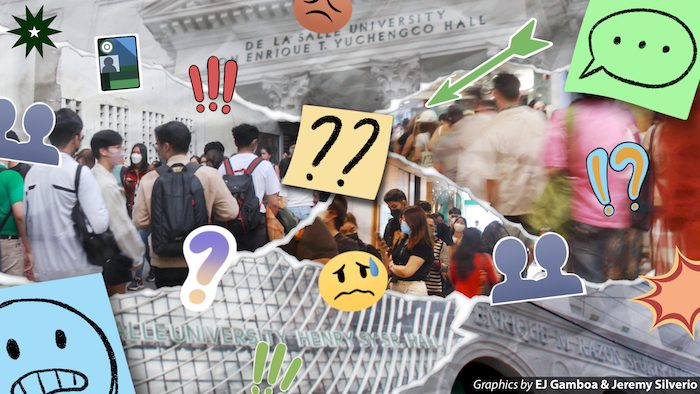The University began its second term for Academic Year (AY) 2022-2023 with most of its classes being held in-person. By observing a rotational schedule for on-site and online classes to prevent overcrowding, DLSU temporarily unburdens itself from accommodating the entire student population on campus at once. But concerns are raised as to how the University will manage full on-site classes, especially in the smaller yet more populated Manila campus.

How things came about
Financial deficits are among the factors attributed to the sharp increase in student population. Vice President for Finance Ramon Trajano previously revealed that the University’s deficits skyrocketed to P683 million in AY 2019-2020. Despite this, a zero-percent tuition fee increase (TFI) was passed for AY 2020-2021 and AY 2021-2022, pushing the administration to enroll more students to remedy their losses.
In turn, DLSU’s statement of activities, obtained by The LaSallian, shows that the University was able to recover from its deficits in the past two years with about a P352-million net gain in 2021 but declining to a P171-million net gain in 2022. Provost Dr. Robert Roleda attributes the University’s recovery from its deficits to its increasing student population, which boosted tuition fee revenue from about P2.1 billion in 2020 to about P2.8 billion in 2021.
“We tried to cut down on expenses but we can only do so much, because ultimately, the source of the deficit is…the fewer number of students. Now, we have a larger number of students…Our student number is increasing. It’s already gone beyond [that of] the pre-K-12 transition,” he explains.
However, Roleda clarifies that the current population is “unexpected”, noting that the number of accepted students who ultimately committed to studying in DLSU “turned out to be higher than the historical trends.” He furthers that, in AY 2021-2022, the University only targeted to enroll about 5,500 freshmen as opposed to the over 6,500 who entered during that time.
As the campus reopens for in-person activities, DLSU now faces the challenge of housing an unprecedented number of students.
Adjusting policies, student services
The University currently implements on-site classes rotationally, where only about 50 percent of the student body is expected to occupy the campus in a day.
The Provost explained in a previous interview that should overcrowding be a major problem for Lasallians, more Wednesday, Saturday, and evening classes will be made available.
Beyond these short-term fixes, Roleda mentions that the first of three phases of constructing the new Mutien Marie Hall is expected to be done by next year. He also notes that the University “cannot really expand in Taft,” so it intends to be “more aggressive” in directing students to the Laguna campus by building new infrastructure and providing new facilities there.
While these developments are underway, Roleda shares that the University no longer plans to implement full face-to-face classes. Instead, it will be improving its current hybrid modality, which was supposed to be only a transitional setup.
To support a large number of students on the major adjustments in learning modality, the University Student Government (USG) aims to “continue having an open dialogue” with the University administration to improve campus services.
The USG also plans to manage the risk of COVID-19 transmission now that more students are on campus by “implementing a COVID-19 tracing system that alerts students if they have been exposed to another student with COVID-19 [and] providing free COVID-19 antigen test kits and insurance to the student body.”
Addressing financial woes, the USG is currently pushing for a zero-percent TFI for AY 2023-2024. Although past proposals were anchored on increasing freshman intake, the USG projects that a zero-percent TFI is still feasible even if DLSU accepts less freshmen for the following AY.
“With the academic calendar back to normal at three terms per AY, the University can expect a more regular stream of tuition fee revenues…The other income streams of the University should be able to cover rising salaries and other expenses and even allow the University to accumulate more capital and upgrade existing facilities, even with a zero-percent TFI,” USG President Alex Brotonel explains.
Roleda raises, however, that TFIs are more “pegged with the inflation rate”, which would push the faculty to ask for salary increases.
Students on the ‘future’
Students have varied reactions to the University’s shift to having more in-person classes.
Julian Reantaso (II, BS-IE) sees in-person classes as an “opportunity to socialize again with blockmates” and has helped him “concentrate and learn more.”
Contrastingly, Josh Borras (I, BS-MKT) says that the University’s decision to push for hybrid learning hinders those who are still recovering and adjusting to the new normal. “There are students [such as] I who [have] to travel long distances just to reach Taft as we still [lack] the financial capacity…to afford a condo or dorm,” he states.
Miguel Pardo (IV, AB-CAM), meanwhile, has a more mixed reaction. “I am personally excited for the return of face-to-face learning, as I have always found it more engaging than the online setting. However, the hybrid setting and adjusting to having some classes online and some [face-to-face] has been a little tiring,” he expresses.
The University administration vows to “fine-tune” current systems. “We are adjusting not just the online sessions, but also the in-person sessions. And we are learning along the way. Hybrid learning is new. Expectedly, we will continue to refine this with the end goal of making sure that we can deliver quality Lasallian education,” Roleda assures.
After all, “This is a taste of our future,” as Roleda explains. “During this term, we will have to see how things go and try to adjust our system so that we can maintain this in the long run…We would like to take advantage of the benefits of online [and] in-person [learning] so we [can] have the best of both worlds, so to speak.”
